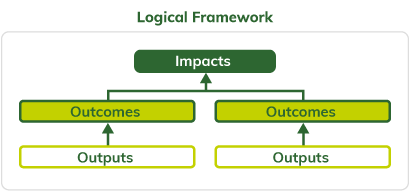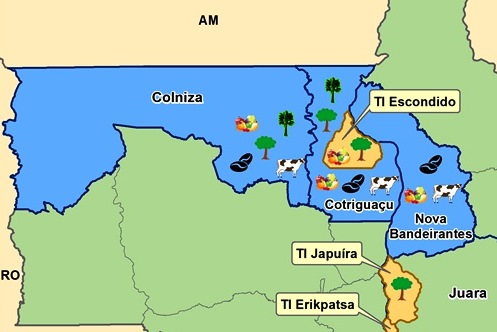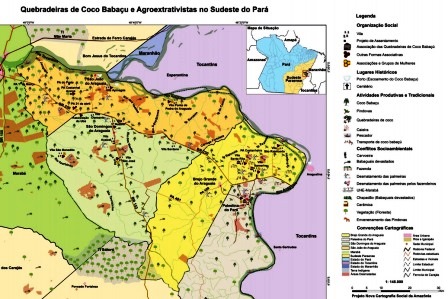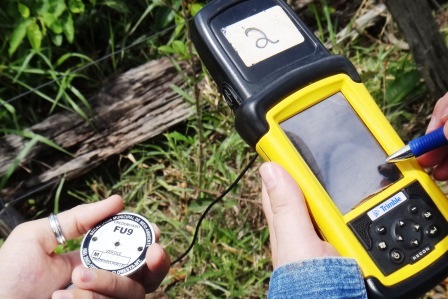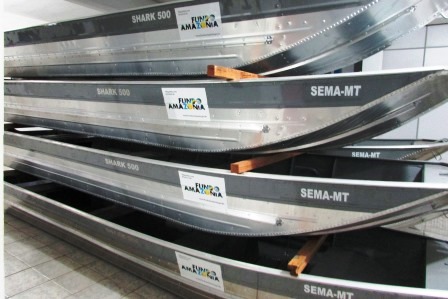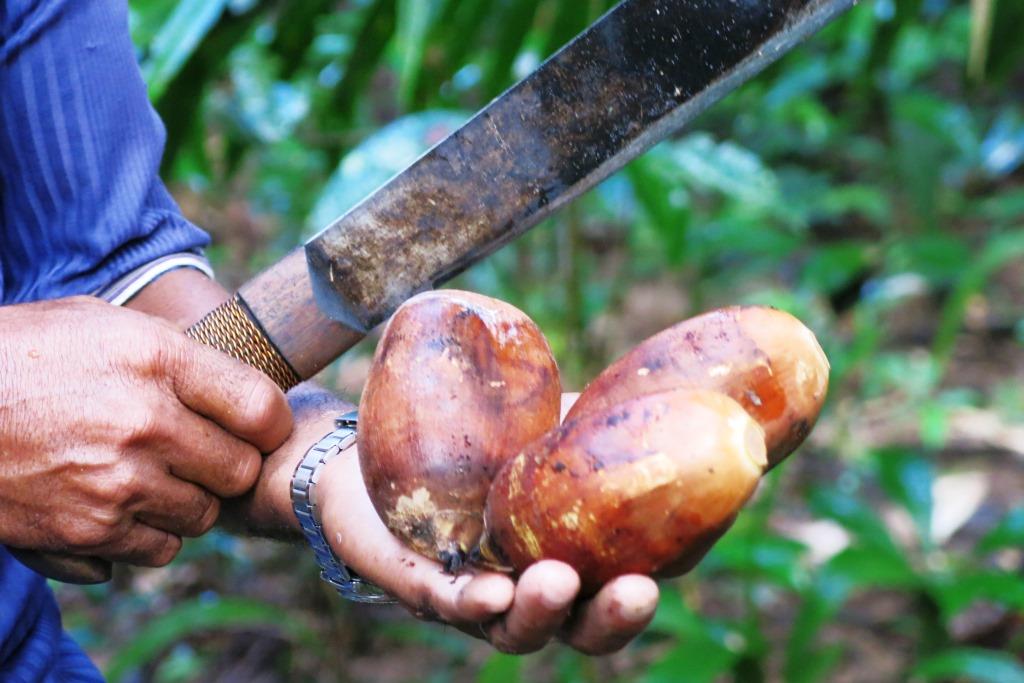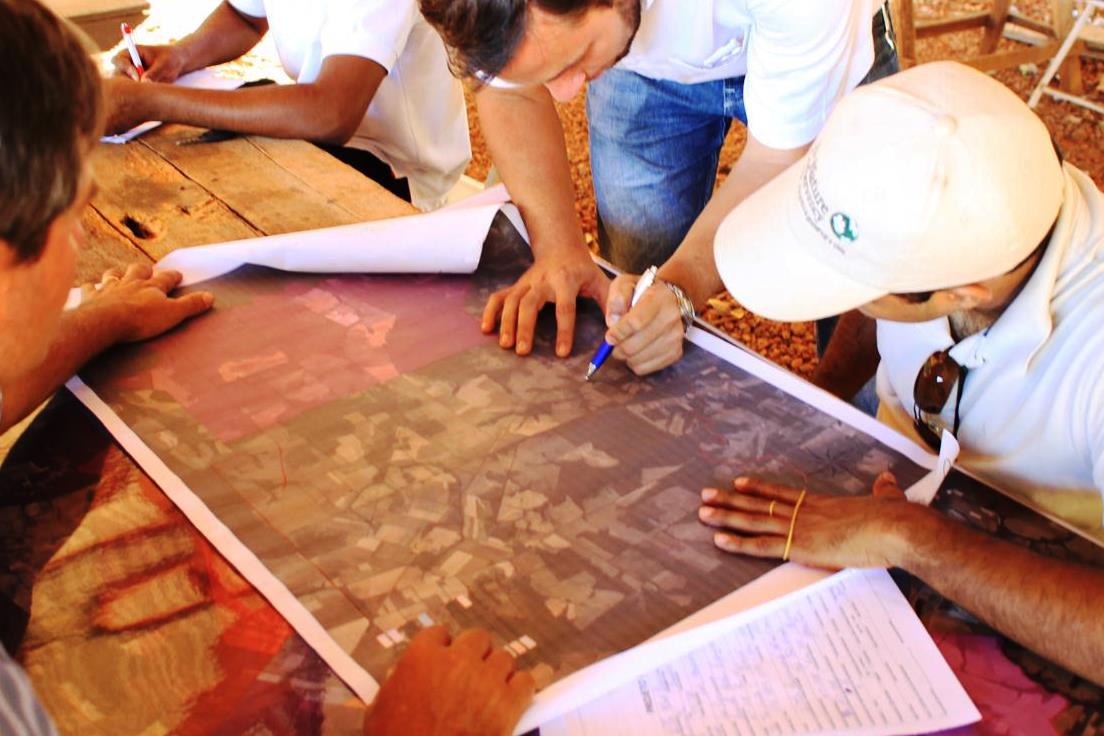Result and impact indicators
The project activities contributed to the expected outcomes of the “sustainable production” (1) and “land-use planning” (3) components of the Amazon Fund’s Logic Framework.
Below are the outcomes of the main agreed indicators for monitoring the predicted direct effects.
Direct effect 1.1 – Economic activities for the sustainable use of biodiversity identified and developed in TI Igarapé Lourdes
- Revenue generated from economic activities of sustainable use – banana and cassava flour (outcome indicator)
Target: not defined | Result achieved: R$ 145,000
The productive activities developed by Indigenous communities usually have as main objective subsistence, since food security is fundamental for these communities. Selling surpluses is also important because it allows the communities to obtain monetary resources. The support provided by the project strengthened the production chains of banana and cassava flour, allowing to expand surplus sales.
The project contributed significantly to diversify the TI income-generating productive activities (banana, flour and fish farming), previously concentrated chestnut exploitation.
Direct effect 1.2 – Extended forest product chains with added value in the TIs Zoró and Igarapé Lourdes
- Brand for Zoró products created and filed for registration (output indicator)
Target: 1 | Result achieved: 1
Value the standing forest includes recognizing the role of traditional communities and their ways of life in the preservation their territories. One way of achieving this recognition is to add value to products from these communities, using a differentiated insertion in the market. Developing a private label allows consumers to identify the socio-environmental value of these products.
Direct effect 1.3 – Expanded managerial and technical capacities for developing economic activities for sustainable use of biodiversity in TIs Igarapé Lourdes and Zoró
- Number of indigenous people trained in sustainable productive activities effectively using the knowledge acquired (outcome indicator)
Target: 60 | Result achieved: 77
- Number of technical assistance men-hour (MH) provided (output indicator)
Target: 960 MH | Result achieved: 7,384 MH
Technical training in productive activities is a permanent demand of indigenous communities, enabling an increase in quality of life and family/community income. A better qualification in performing these activities positively impacts the family’s routine and any gain in efficiency is immediately perceived.
The project has had a significant result in providing technical assistance, which greatly helps communities in incorporating the knowledge acquired, and also creates conditions for the sustainability of the project results.
Direct effect 1.4 – Deforested and degraded areas recovered and used for food security and ecological conservation in TI Zoró
- Area recovered by SAFs (output indicator)
Target: 10 ha | Result achieved: 10 ha
- Number of nurseries implanted (output indicator)
Target: 2 | Result achieved: 2
Recovery of areas and implementation of nurseries in TI Zoró are activities that allow, in addition to environmental benefits, social and economic gains from agroforestry systems (SAF) production and seedlings. Selling seedlings of native forest species is a segment with good prospects due to the plant recovery determinations of the Forestry Code.
Direct effect 3.2 – TIs Rio Guaporé and Rio Negro Ocaia with defined land-use and environmental management and TI Igarapé Lourdes territorially protected
- Number of published PGTAs (output indicator)
Target: 2 | Result achieved: 2
The established PGTAs are an important achievement for the indigenous communities, signaling a systematization of needs and priorities in managing their territories. PGTAs can be used as a subsidy in the dialogue with public institutions, and in developing projects for fundraising, also meaning that these communities underwent a participatory planning process, which assumes special relevance in societies where the collective good act as the main organizer of social life.
- Number of territorial invasions and other socio-environmental conflicts observed in TI Igarapé Lourdes (outcome indicator)
Baseline: 5 | Observed result: 13
- Number of indigenous people trained for territorial surveillance (output indicator)
Target: 30 | Result achieved: 41
- Number of surveillance expeditions carried out at TI Igarapé Lourdes (output indicator)
Target: 10 | Result achieved: 13
One of PNGATI main objectives is to ensure the integrity of indigenous territories. The front line of territorial protection has been carried out by indigenous people, using surveillance expeditions and observation of the territory. Training is important because it allows communities to use geo-technological resources such as GPS, to subsequently alert the competent authorities if necessary. The increased number of identified occurrences may reflect an improvement in these communities’ surveillance capacity but may also result from the increase in invasions observed in the TI Igarapé Lourdes.
As a general result, the implementation of the project benefited 2,840 indigenous inhabitants from the four TIs.
The table below presents the evolution of deforestation in the last four years in the four TIs benefited by the project, including the total area deforested. The figures are largely consistent with the overall picture observed in the Amazonian TIs, of low deforestation rates. The exception was the high deforestation observed in the 2018 Forestry year in TI Zoró, corresponding to 15% of all forest removal already observed in that TI (about 38 hectares deforested in 2018 vis-à-vis a total deforestation in this TI of approximately 251 hectares).
It has been observed, however, that some factors may contribute to increased deforestation in TIs in general, such as: insufficient repression of environmental crimes; increased international prices of agricultural commodities; improved roads facilitating logistics of access to TIs; and co-optation of indigenous people by invaders to steal timber or practice illegal mining.
| |
TI
|
Area (km²)
|
Total deforestation (km²)
|
%
|
Annual increments (km2)
|
| |
2016
|
2017
|
2018
|
2019
|
|
PGTA implementation
|
Igarapé Lourdes
|
2,037.70
|
78.27
|
3.8%
|
1.55
|
0.33
|
0.53
|
2.18
|
|
Zoró
|
3,634.50
|
251.36
|
6.9%
|
2.1
|
0.08
|
38.27
|
3.22
|
|
PGTA development
|
Rio Guaporé
|
1,251.40
|
30.21
|
2.4%
|
0.18
|
0.79
|
1.83
|
1.47
|
|
Rio Negro Ocaia
|
1,087.20
|
11.06
|
1.0%
|
0
|
0.08
|
0.4
|
0
|
source: dpi.inpe.br/prodesdigital/prodesuc.php
Institutional and administrative aspects
The project was executed in all the planned actions, and the greatest difficulties came from its context of action, since the pressures on the indigenous lands where the project is developed are high In the TIs Zoró and Igarapé Lourdes, access is by land, which favors invasions for timber theft, mining and other threats. Executing the project in this scenario was difficult, as the team was constantly the target of intimidation and threats, which required increased attention.
On project execution and implementation of activities, we highlight the strategy adopted of hiring indigenous people to act as coordinators and assistants of the activities developed. Representatives for each component were chosen collectively and remained in the areas, directly with the communities, being an agent of the project of continued presence in the field. According to Kanindé, this approach was successful because each coordinator developed skills relevant to project management, being responsible for budgets, quotes, accountability, attendance list and others. This training of skills is a positive externality of the project, which may become relevant for future initiatives in the territory, led by the indigenous agents themselves.
Risks and lessons learned
Within the difficult context mentioned above, one impactful situation was a fire in an area recovered by the project, which according to the Association of the Zoró Indigenous People (APIZ) may have been caused by invaders in retaliation to the inspection activities carried out by the indigenous people in the territory. Nevertheless, the five nurserymen trained by the project continue to produce seedlings, aiming at recovering losses from the fire, and also at selling seedlings.
As the project operates in territories with presence of illegal activities, Kanindé guided its team to always walk in pairs, and if possible, accompanied by a member of the indigenous community.
Although the dialogue between the indigenous people, Funai and the project executors had its tensions, the beneficiary evaluated choosing an indigenous person as one of the project coordinators as a good solution, which allowed others to better understand the actions.
The community centers built favored the indigenous people’s self-esteem and autonomy, despite the difficulties for civil works companies to access the indigenous lands due to the distances and poor roads.
Sustainability of results
According to the community, the training and expeditions were very fruitful, and the indigenous people have been able to continue the dynamics of surveillance of the territory. Integrating the acquired knowledge into the community’s routine is conducive for the continuity of this type of activity.
A partnership was established between the associations of the Gavião and Arara peoples (who share the same indigenous land – TI Igarapé Lourdes), so that the vehicles and equipment acquired by the project were distributed, aiming at their better use and maintenance. The truck acquired early in the project, to aid the production of TI Igarapé Lourdes, enabled the flow of production, which could not be done before, and the associates created a collection fund with part of the income obtained from the productive activities for maintaining the truck.
Fish farming, which was primarily thought for subsistence, was evolving well, and by the end of the project, the community expressed their intention to begin selling fish in the local trade, and, in the future, for government procurement programs. Diversifying income sources is important for several reasons, such as, for instance, the seasonality of some of the products explored, like the Brazil nut.


